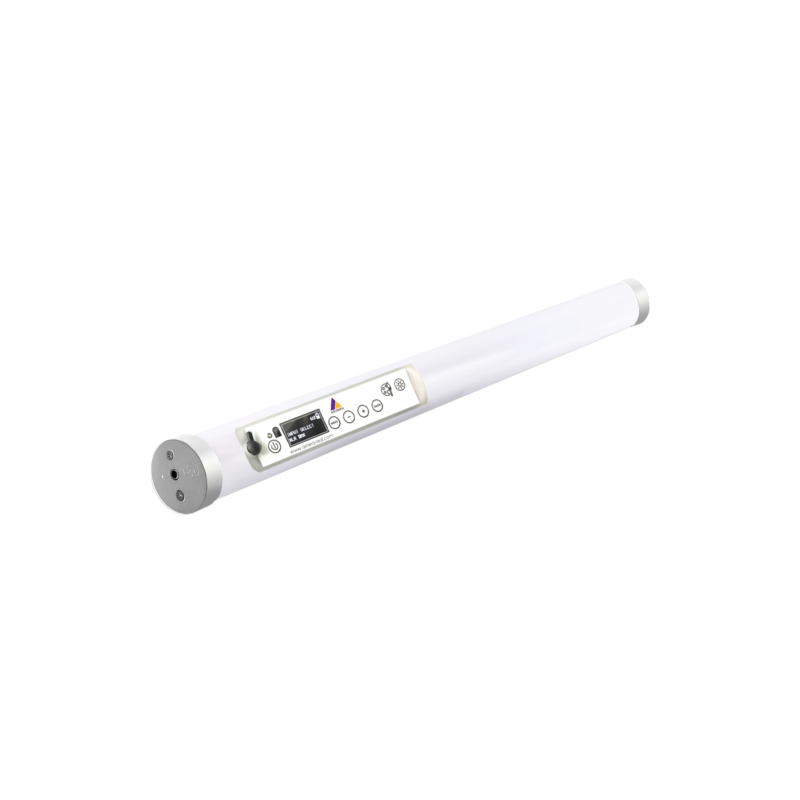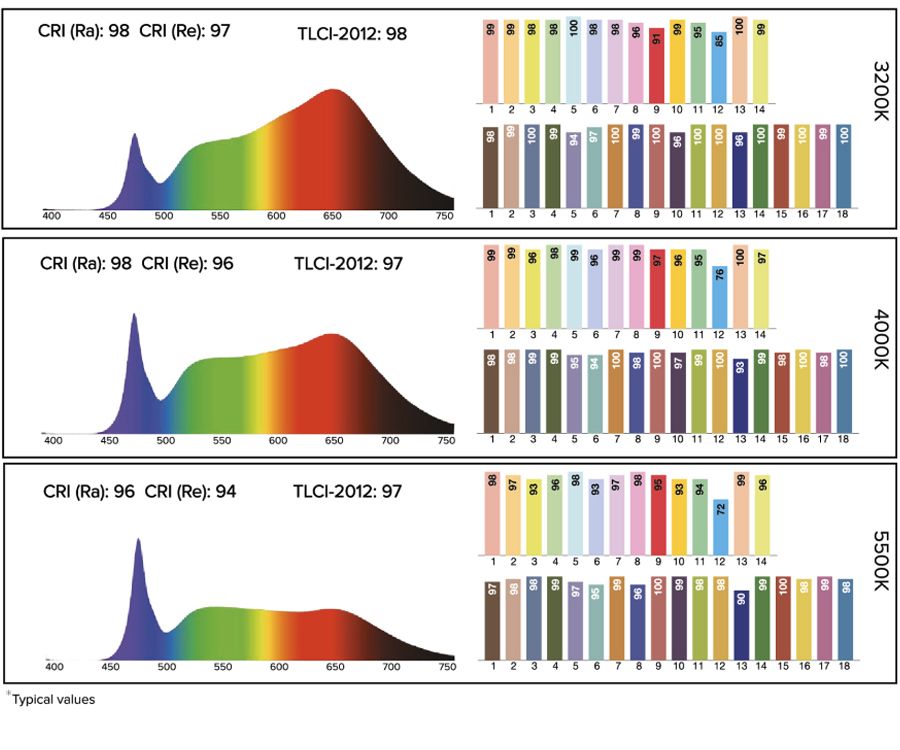Пожалуйста, примите к сведению, что из-за дефицита компонентов нам пришлось внести изменения во внутреннюю конструкцию Helios, а также других приборов, выпущенных после октября 2021 года. Теперь все эти решения поддерживают функцию BTB (Bluetooth Bridge), вследствие этого был добавлен новый артикул – FP2-BTB.

Примечание
Технические характеристики
Артикул | FP2 | FP2-BTB |
|---|---|---|
Светодиодный модуль | Светодиодный модуль Titan | Светодиодный модуль Titan |
Цвета | RGB+мята+янтарь | RGB+мята+янтарь |
Общая мощность светодиодов | 36 Вт | 36 Вт |
Передаваемая мощность светодиодов | 24 Вт | 24 Вт |
Световой выход при 3200K | 1 285 люмен | 1 285 люмен |
Световой выход при 4000К | 1 340люмен | 1 340 люмен |
Освещенность при 3200 K на 1 м | 360 люкс | 360 люкс |
Освещенность при 4000 К на 1 м | 393 люкс | 393 люкс |
CRI (Ra)/ TLCI 3200- 6500 K* | ≥96 | ≥96 |
Угол раскрытия луча | 135° x 115° | 135° x 115° |
Угол поля | 135° x 115° | 135° x 115° |
Стробоскопические эффекты | 0 – 25 Гц | 0 – 25 Гц |
Количество пикселей | 8 | 8 |
Время работы от аккумулятора | до 20 часов | до 20 часов |
Ресурс аккумулятора | 70 % после 300 циклов | 70 % после 300 циклов |
Время зарядки (номинал) | 3 часа | 3 часа |
Вход постоянного тока | 24 В постоянного тока – 1,25 А | 24 VDC постоянного тока – 1,25 А |
Разъем питания постоянного тока | 5,5 мм x 2,1 мм | 5,5 мм x 2,1 мм |
Проводной DMX | Да (via FP1-PWB / FP3-DTL / PWB-2-86) | Да (via FP1-PWB / FP3-DTL / PWB-2-86) |
CRMX-приемник | Встроенный | Встроенный |
BluetoothBridge BTB | Нет | Да |
Беспроводные протоколы | CRMX, УВЧ | CRMX, УВЧ, Bluetooth, WiFi |
Диапазон беспроводной связи | CRMX/УВЧ До 300 м | CRMX/УВЧ До 300 м Bluetooth До 3 м |
ИК-управление | Да | Да |
Степень защиты | IP65 (только с FP1-SP) | IP65 (только с FP1-SP) |
Рабочая температура окружающей среды | 0 – 40 °C / 32 – 104 °F | 0 – 40 °C |
Вес | 0.765 kg | 0.765 kg |
Размеры (L x Ø) | 550 mm x Ø 43 mm / 21.7" x Ø 1.7" | 550 mm x Ø 43 mm / 21.7" x Ø 1.7" |
Варианты монтажа | 2 x резьбовых отвестия M5, 2 x держателя (с 2 резьбовыми отверстиями M5 и 1x 1/4"-20UNC), 1 х стойка | 2 x резьбовых отвестия M5, 2 x держателя (с 2 резьбовыми отверстиями M5 и 1x 1/4"-20UNC), 1 х стойка |
*Типовые значения
Что внутри?
- 1 x Helios Tube (FP2-BTB)
- 2 x TubeHolder (AX1-H)
- 1 x TubeStand (AX1-STD)
- 2 x Eyebolt (FP1-EBLT)
- 1 x DC Socket Cover (FP1/2-SP)
Типовые спектры
Радиочастотные характеристики
Для FP2 Helios Tube
Wireless Modules | Modulation | ERP (Transmitter) | Channel Count |
|---|---|---|---|
EU: UHF***(863-870MHz) | FHSS | <25mW | 47 |
USA: UHF (917-922.20MHz) | FHSSFHSS | <25mW | 53 |
AUS: UHF (922.30-927.50MHz) | FHSS | <25mW | 53 |
SGP: UHF (920.50-924.50MHz) | FHSS | <25mW | 41 |
KOR: UHF (917.9-921.5MHz) | FHSS | <25mW | 10 |
RUS: UHF (868.75-869.12MHz) | FHSS | <25mW | 6 |
JPN: UHF (922.80-926.40MHz) | FHSS | <25mW | 19 |
CRMX (2402-2480MHz) | FHSS | – | 79 |
***General allocation of frequencies for use by short-range radio applications Spectrum usage regulations:
Frequency range in MHz1) | Maximum equivalent radiant power (ERP) | Additional parameters / frequency access and interference mitigation techniques |
|---|---|---|
865 – 868 | 25 mW | Requirements for frequency access and mitigation techniques3) Alternatively, a maximum duty cycle2) of 1% can be used. |
868,0 – 868,6 | 25 mW | Requirements for frequency access and mitigation techniques3) Alternatively, a maximum duty cycle2) of 1% can be used. |
868,7 – 869,2 | 25 mW | Requirements for frequency access and mitigation techniques3) Alternatively, a maximum duty cycle2) of 0.1% can be used. |
869,40 – 869,65 | 500 mW | Requirements for frequency access and mitigation techniques3) Alternatively, a maximum duty cycle2) of 10% can be used. |
869,7 – 870,0 | 25 mW | Requirements for frequency access and mitigation techniques3) Alternatively, a maximum duty cycle2) of 1% can be used. |
1) The use of adjacent frequency bands within this table as a single frequency band is permitted, provided that the specific conditions for each of these adjacent frequency bands are met. 2) „duty cycle“ means the ratio of Σ(Ton)/(Tobs) expressed as a percentage, where ‚Ton‘ is the ‚on-time‘ of a single transmitting device and ‚Tobs‘ is the observation period Ton is measured in an observation frequency band (Fobs). Unless otherwise specified in this general allocation, Tobs is a continuous period of one hour and Fobs is the applicable frequency band in this general allocation (table). 3) Frequency access and interference mitigation techniques shall be used whose performance level at least meets the essential requirements of Directive 2014/53/EU or the Radio Equipment Act (FuAG). Where relevant techniques are described in harmonised standards, the references of which have been published in the Official Journal of the European Union pursuant to Directive 2014/53/EU, or parts thereof, performance shall be ensured which is at least equivalent to those techniques.
Для FP2-BTB Helios Tube
Wireless Modules | Modulation | ERP (Transmitter) | Channel Count |
|---|---|---|---|
EU: UHF***(863-870MHz) | FHSS | <25mW | 47 |
USA: UHF (917-922.20MHz) | FHSS | <25mW | 53 |
AUS: UHF (922.30-927.50MHz) | FHSS | <25mW | 53 |
SGP: UHF (920.50-924.50MHz) | FHSS | <25mW | 41 |
KOR: UHF (917.9-921.5MHz) | FHSS | <25mW | 10 |
RUS: UHF (868.75-869.12MHz) | FHSS | <25mW | 6 |
JPN: UHF (922.80-926.40MHz) | FHSS | <25mW | 19 |
CRMX (2402-2480MHz) | FHSS | – | 79 |
Bluetooth 5.0 LE (2402-2480MHz) | FHSS | 10mW (BLE) | 40 |
WiFi (2412-2472MHz) | DSSS, OFDM | <100mW | 13 |
***General allocation of frequencies for use by short-range radio applications Spectrum usage regulations:
Frequency range in MHz1) | Maximum equivalent radiant power (ERP) | Additional parameters / frequency access and interference mitigation techniques |
|---|---|---|
865 – 868 | 25 mW | Requirements for frequency access and mitigation techniques3) Alternatively, a maximum duty cycle2) of 1% can be used. |
868,0 – 868,6 | 25 мВт | Requirements for frequency access and mitigation techniques3) Alternatively, a maximum duty cycle2) of 1% can be used. |
868,7 – 869,2 | 25 mW | Requirements for frequency access and mitigation techniques3) Alternatively, a maximum duty cycle2) of 0.1% can be used. |
869,40 – 869,65 | 500 mW | Requirements for frequency access and mitigation techniques3) Alternatively, a maximum duty cycle2) of 10% can be used. |
869,7 – 870,0 | 25 mW | Requirements for frequency access and mitigation techniques3) Alternatively, a maximum duty cycle2) of 1% can be used. |
1) The use of adjacent frequency bands within this table as a single frequency band is permitted, provided that the specific conditions for each of these adjacent frequency bands are met. 2) „duty cycle“ means the ratio of Σ(Ton)/(Tobs) expressed as a percentage, where ‚Ton‘ is the ‚on-time‘ of a single transmitting device and ‚Tobs‘ is the observation period Ton is measured in an observation frequency band (Fobs). Unless otherwise specified in this general allocation, Tobs is a continuous period of one hour and Fobs is the applicable frequency band in this general allocation (table). 3) Frequency access and interference mitigation techniques shall be used whose performance level at least meets the essential requirements of Directive 2014/53/EU or the Radio Equipment Act (FuAG). Where relevant techniques are described in harmonised standards, the references of which have been published in the Official Journal of the European Union pursuant to Directive 2014/53/EU, or parts thereof, performance shall be ensured which is at least equivalent to those techniques.
